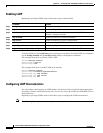
26-8
Catalyst 2960 and 2960-S Switch Software Configuration Guide
OL-8603-09
Chapter 26 Configuring LLDP, LLDP-MED, and Wired Location Service
Configuring LLDP, LLDP-MED, and Wired Location Service
Beginning in privileged EXEC mode, follow these steps to enable a TLV on an interface:
This example shows how to enable a TLV on an interface:
Switch# configure terminal
Switch(config)# interface gigabitethernet0/1
Switch(config-if)# lldp med-tlv-select inventory-management
Switch(config-if)# end
Configuring Network-Policy TLV
Beginning in privileged EXEC mode, follow these steps to create a network-policy profile, configure the
policy attributes, and apply it to an interface.
Command Purpose
Step 1
configure terminal Enter global configuration mode.
Step 2
interface interface-id Specify the interface on which you are configuring an LLDP-MED
TLV, and enter interface configuration mode.
Step 3
lldp med-tlv-select tlv Specify the TLV to enable.
Step 4
end Return to privileged EXEC mode.
Step 5
copy running-config startup-config (Optional) Save your entries in the configuration file.
Command Purpose
Step 1
configure terminal Enter global configuration mode.
Step 2
network-policy profile profile number Specify the network-policy profile number, and enter network-policy
configuration mode. The range is 1 to 4294967295.
Step 3
{voice | voice-signaling} vlan [vlan-id
{cos cvalue | dscp dvalue}] | [[dot1p
{cos cvalue | dscp dvalue}] | none |
untagged]
Configure the policy attributes:
voice—Specify the voice application type.
voice-signaling—Specify the voice-signaling application type.
vlan—Specify the native VLAN for voice traffic.
vlan-id—(Optional) Specify the VLAN for voice traffic. The range is 1 to
4094.
cos cvalue—(Optional) Specify the Layer 2 priority class of service (CoS)
for the configured VLAN. The range is 0 to 7; the default is 5.
dscp dvalue—(Optional) Specify the differentiated services code point
(DSCP) value for the configured VLAN. The range is 0 to 63; the default
is 46.
dot1p—(Optional) Configure the telephone to use IEEE 802.1p priority
tagging and use VLAN 0 (the native VLAN).
none—(Optional) Do not instruct the IP telephone about the voice VLAN.
The telephone uses the configuration from the telephone key pad.
untagged—(Optional) Configure the telephone to send untagged voice
traffic. This is the default for the telephone.
Step 4
exit Return to global configuration mode.


















